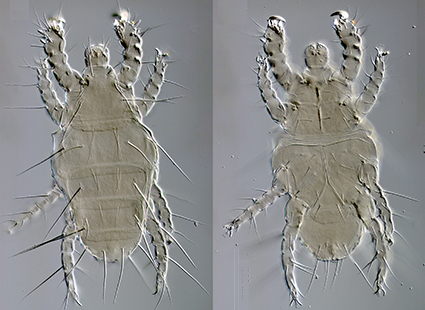Abstract
A new genus and three new species of Athyreacaridae (Acari: Heterostigmata) are described associated with beetles of subfamily Bolboceratinae (Coleoptera: Geotrupidae) in Neotropical and Afrotropical realms: Neoathyreacarus pygmephoroides gen., sp. nov. collected on Bolborhinum tubericeps in Chile; Athyreacarus staturosus sp. nov. collected on Zefevazia cantisani in Argentina; and Athyreacarus camerikae sp. nov. collected on Namibiobolbus helgae in South Africa. An updated key to genera and species of Athyreacaridae is provided. Athyreacarus staturosus sp. nov. is the largest ever described non-physogastric female among Heterostigmata.
References
Grandjean, F. (1944) Observations sur les Acariens de la famille des Stigmaeidae. Archives des Sciences Physiques et Naturelles, 26, 103–131.
Grandjean, F. (1947) L’origine pileuse des mors et la chaetotaxie de la mandibule chez les Acariens actinochitineux. Comptes rendus des Séances de l’Academie des Sciences, 224, 1251–1254.
Khaustov, A.A. (2000) Bembidiacaridae, a new family of mites (Acari: Heterostigmata), associated with carabid beetles of the genus Bembidion (Coleoptera: Carabidae). Acarina, 8, 3–8.
Khaustov, A.A. & Frolov A.V. (2017) New species of heterostigmatic mites (Acari: Heterostigmata: Athyreacaridae, Dolichocybidae, Pygmephoridae) associated with scarab beetles (Coleoptera: Geotrupidae, Scarabaeidae) from Brazil. Zootaxa, 4294 (5), 501–521. https://doi.org/10.11646/zootaxa.4294.5.1
Khaustov, A.A. & Frolov, A.V. (2019) Revision of the genus Athyreacarus (Acari: Athyreacaridae). Zootaxa, 4647 (1), 168–225. https://doi.org/10.11646/zootaxa.4647.1.14
Khaustov, A.A. & Frolov, A.V. (2020) First record of Athyreacaridae (Acari: Heterostigmata) from Asia with description of two new species of Athyreacarus from India and Sri Lanka. Zootaxa, 4779 (2), 260–272. https://doi.org/10.11646/zootaxa.4779.2.7
Khaustov, A.A. & Frolov, A.V. (2021) First record of Athyreacaridae (Acari: Heterostigmata) from Africa with description of four new species of Athyreacarus. Systematic & Applied Acarology, 26 (8), 1437–1457. https://doi.org/10.11158/saa.26.8.4
Lindquisst, E.E. (1969) Review of Holarctic tarsonemid mites (Acarina: Prostigmata) parasitizing eggs of Ipine bark beetles. Memoirs of the Entomological Society of Canada, 60, 5–111. https://doi.org/10.4039/entm10160fv
Lindquist, E.E. (1986) The world genera of Tarsonemidae (Acari: Heterostigmata): a morphological, phylogenetic, and systematic revision, with a reclassification of family-group taxa in the Heterostigmata. Memoirs of the Entomological Society of Canada, 118, 1–517. https://doi.org/10.4039/entm118136fv
Lindquist, E.E., Kaliszewski, M. & Rack, G. (1990) Athyreacaridae, a new family of mites (Acari: Heterostigmata) associated with scarab beetles of the genus Neoathyreus (Coleoptera: Scarabaeidae). Acarologia, 31, 161–176.
Lindquist, E.E. & Krantz, G.W. (2002) Description of, and validation of names for, the genus Crotalomorpha and the family Crotalomorphidae (Acari: Heterostigmata). Systematic & Applied Acarology, 7, 129–142. https://doi.org/10.11158/saa.7.1.14
Schuster, R.O. & Lavoipierre, M.M.J. (1970) The mite family Heterocheylidae Trägardh. Occasional papers of the California Academy of Sciences, 85, 42 pp.
Walter, D.E., Lindquist, E.E., Smith, I.M., Cook, D.R. & Krantz, G.W. (2009) Order Trombidiformes. In: Krantz, G.W. & Walter, D.E. (Eds.), A Manual of Acarology. Third Edition. Texas Tech University Press, Lubbock, Texas, pp. 223–420.


